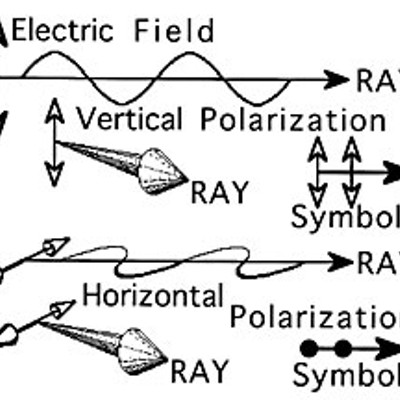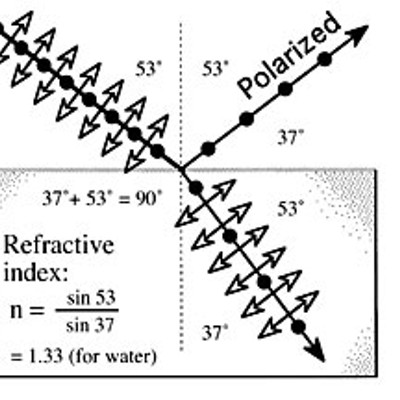If you wish to see submerged rocks ahead, or creatures in a tide pool, you need to wear Polaroid sunglasses. Their ability to reduce glare is a consequence of some very interesting physics. I will demonstrate, for example, that when you see light reflected from a surface, that light did not simply bounce off the surface. The light you see was actually produced by vibrating electrons within the illuminated liquid (or solid). Those electrons were made to vibrate by the primary light, and the vibrating electrons radiated secondary light which entered your eyes.
Light consists of electromagnetic waves, but we can here ignore the magnetic part. A light ray consists of countless individual photons with each photon's electric field oscillating at right angles to the ray (Diagram A). If the ray is polarized, all the photons share the same direction of oscillation. Unpolarized light is oscillating in all possible directions.
Consider unpolarized light illuminating water (Diagram B). At a certain angle your Polaroid glasses will completely block the reflected ray! That ray is perfectly polarized, and it departs the water at 90 degrees to the refracted ray! The explanation lies in the fact that electrons within the water molecules are induced to vibrate parallel to the electric fields of the refracted ray. Furthermore, electrons cannot radiate light in the direction of their vibration. Only those vibrations which cross your line of sight can yield light that enters your eyes. Hence, your eyes receive horizontally polarized light which will be blocked by Polaroid sunglasses. Although reflected light may appear to bounce off the water's surface, and you may see an image of the light source, the light actually originates from a thin layer of water near the surface. Interference between adjacent rays prevents radiation from below that thin layer.
Ladies, if your man declares that your skin is glowing or your hair is shining, he is really telling you the truth: Your electrons are visibly jiggling.






Comments